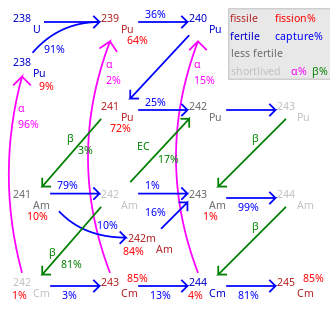Breeder reactor





Breeder reactor is a type of nuclear reactor that generates more fissile material than it consumes. These reactors are significant in the context of nuclear power generation because they can extend the fuel supply for nuclear energy production by generating more fuel than they use up. This is achieved through a process called breeding, in which fertile materials, such as Uranium-238 (U-238) or Thorium-232 (Th-232), are converted into fissile materials, such as Plutonium-239 (Pu-239) or Uranium-233 (U-233), respectively.
Overview[edit]
Breeder reactors are designed to address the issue of finite uranium resources by efficiently utilizing the abundant, but non-fissile, U-238 available in natural uranium. Through neutron absorption and subsequent nuclear reactions, these reactors convert U-238 into Pu-239, a fissile material that can sustain a nuclear chain reaction. Similarly, when thorium is used as fuel, Th-232 is converted into U-233, another fissile material.
Types of Breeder Reactors[edit]
There are two main types of breeder reactors, based on the type of neutron used in the breeding process: Fast Breeder Reactors (FBRs) and Thermal Breeder Reactors.
Fast Breeder Reactors[edit]
FBRs use fast neutrons to convert fertile material into fissile material. They do not require a neutron moderator, as the fast neutrons are more efficient at breeding fissile material from fertile material. The most common coolant used in FBRs is liquid sodium, which has excellent thermal properties and does not moderate neutrons.
Thermal Breeder Reactors[edit]
In contrast, thermal breeder reactors use thermal (slow) neutrons and require a moderator to slow down the neutrons produced by fission. An example of a thermal breeder reactor is the Molten Salt Reactor (MSR), which uses a mixture of molten salts as both fuel and coolant, and can operate with thorium as fuel.
Advantages and Disadvantages[edit]
Breeder reactors offer several advantages, including better utilization of natural uranium resources, the ability to generate their own fuel, and the potential to reduce nuclear waste by burning long-lived actinides. However, they also face challenges such as higher costs, technical complexity, and concerns related to nuclear proliferation due to the production of plutonium.
Current Status and Future[edit]
As of now, several countries have pursued breeder reactor programs, with varying degrees of success. Russia has been operating a fast breeder reactor, the BN-600, for several decades, and has developed a newer model, the BN-800. Other countries, including India and China, are also developing breeder reactor technology.
The future of breeder reactors depends on advancements in technology, economic factors, and societal acceptance of nuclear power. Research continues into making breeder reactors more economically viable and addressing proliferation concerns.
Ad. Transform your life with W8MD's Budget GLP-1 injections from $75


W8MD offers a medical weight loss program to lose weight in Philadelphia. Our physician-supervised medical weight loss provides:
- Weight loss injections in NYC (generic and brand names):
- Zepbound / Mounjaro, Wegovy / Ozempic, Saxenda
- Most insurances accepted or discounted self-pay rates. We will obtain insurance prior authorizations if needed.
- Generic GLP1 weight loss injections from $75 for the starting dose.
- Also offer prescription weight loss medications including Phentermine, Qsymia, Diethylpropion, Contrave etc.
NYC weight loss doctor appointmentsNYC weight loss doctor appointments
Start your NYC weight loss journey today at our NYC medical weight loss and Philadelphia medical weight loss clinics.
- Call 718-946-5500 to lose weight in NYC or for medical weight loss in Philadelphia 215-676-2334.
- Tags:NYC medical weight loss, Philadelphia lose weight Zepbound NYC, Budget GLP1 weight loss injections, Wegovy Philadelphia, Wegovy NYC, Philadelphia medical weight loss, Brookly weight loss and Wegovy NYC
|
WikiMD's Wellness Encyclopedia |
| Let Food Be Thy Medicine Medicine Thy Food - Hippocrates |
Medical Disclaimer: WikiMD is not a substitute for professional medical advice. The information on WikiMD is provided as an information resource only, may be incorrect, outdated or misleading, and is not to be used or relied on for any diagnostic or treatment purposes. Please consult your health care provider before making any healthcare decisions or for guidance about a specific medical condition. WikiMD expressly disclaims responsibility, and shall have no liability, for any damages, loss, injury, or liability whatsoever suffered as a result of your reliance on the information contained in this site. By visiting this site you agree to the foregoing terms and conditions, which may from time to time be changed or supplemented by WikiMD. If you do not agree to the foregoing terms and conditions, you should not enter or use this site. See full disclaimer.
Credits:Most images are courtesy of Wikimedia commons, and templates, categories Wikipedia, licensed under CC BY SA or similar.
Translate this page: - East Asian
中文,
日本,
한국어,
South Asian
हिन्दी,
தமிழ்,
తెలుగు,
Urdu,
ಕನ್ನಡ,
Southeast Asian
Indonesian,
Vietnamese,
Thai,
မြန်မာဘာသာ,
বাংলা
European
español,
Deutsch,
français,
Greek,
português do Brasil,
polski,
română,
русский,
Nederlands,
norsk,
svenska,
suomi,
Italian
Middle Eastern & African
عربى,
Turkish,
Persian,
Hebrew,
Afrikaans,
isiZulu,
Kiswahili,
Other
Bulgarian,
Hungarian,
Czech,
Swedish,
മലയാളം,
मराठी,
ਪੰਜਾਬੀ,
ગુજરાતી,
Portuguese,
Ukrainian


